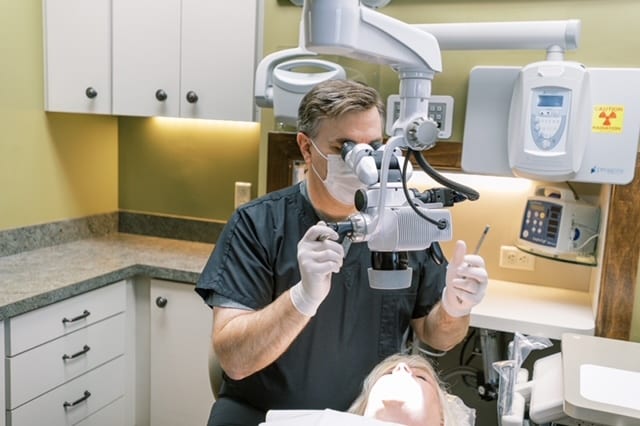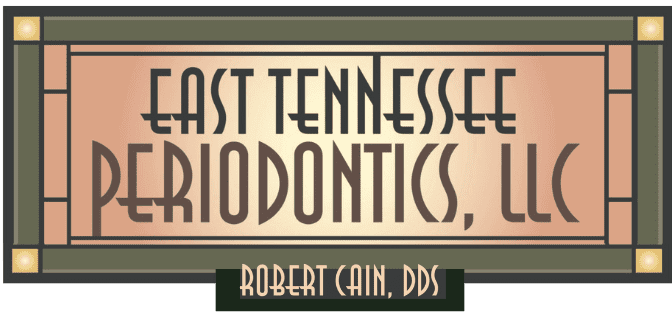An experienced periodontist in Knoxville, TN, Dr. Robert Cain provides comprehensive and personalized diagnosis and treatment of periodontal disease and its associated side effects. Our East Tennessee periodontal office provides a range of periodontal procedures for conservative treatment of gum health and aesthetic concerns.
Periodontal plastic surgery includes several procedures used to restore the appearance of the gum line cosmetically. It can reshape and recontour the gum line for a more aesthetically balanced smile that supports a healthy oral foundation.

Periodontal Surgery in Knoxville, TN
Periodontal plastic surgery techniques can treat a range of periodontal concerns, including:
- Add gum tissue around teeth
- Remove gum tissue
- Bring balance between the gum-to-tooth ratio
- Improve the appearance of the teeth and smile
WHAT TO EXPECT:
Dr. Robert Cain will provide a thorough oral health exam to determine the best treatment plan for your oral health concerns and cosmetic goals. Depending on the health of your gums and teeth, Dr. Cain may recommend a periodontal surgery option to help restore your smile.
There are two categories of periodontal plastic surgery procedures: tissue additive and tissue subtractive.
PERIODONTAL PLASTIC SURGERY SERVICES INCLUDE:
Frenectomy
Osseous Surgery
Pinhole Gum Surgery
Sinus Lift Surgery
Soft Tissue Allograft
Soft Tissue Grafting
Patients may need one or more periodontal treatments to achieve optimal oral health.
TISSUE ADDITIVE PROCEDURES
Tissue additive procedures add soft tissues to areas in the mouth where the gum tissues may have receded. Dr. Cain commonly uses two procedures to repair receding gums: subepithelial connective tissue grafts and soft tissue allografts.
Subepithelial Connective Tissue Grafts: Subepithelial grafts add gingival tissue to cover exposed tooth roots. We transplant this tissue from a small incision in the roof of the patient’s mouth or palate. The tissue is then surgically implanted in the area of the exposed root. This procedure is a two-step treatment.
Dr. Cain’s experience and skill set allow for natural and predictable results. Covering exposed tooth roots can help minimize tooth pain and sensitivity and prevent future tooth loss of the affected tooth.
Soft Tissue Allografts: Similar to the subepithelial connective tissue grafts, soft tissue allografts can repair an exposed tooth root or reshape a receding gum line. We use sterile dermal tissue derived from human donors in a soft tissue allograft.
The advantages of soft tissue allografts are that the patients only require one procedure and do not have to graft their tissue. Soft tissue allografts also allow for more teeth to be repaired at once, as Dr. Cain is not limited by the amount of tissue he can remove from the platelet.
TISSUE SUBTRACTIVE PROCEDURES
We use tissue subtractive procedures to remove and reshape excess gum tissue, often called a “gummy smile.” Tissue subtractive procedures can restore the balance and aesthetics of your teeth and gums. The two main tissue subtractive procedures are gingivectomy and esthetic crown lengthening.
Gingivectomy: A gingivectomy removes excess tissue covering the tooth surface. This tissue build-up is also commonly referred to as gingival hyperplasia. Orthodontic appliances, certain medications, and genetics can all cause gingival hyperplasia.
Dr. Cain performs the gingivectomy procedure using noninvasive lasers. The state-of-the-art technology can remove excess tissue and recontour the shape and thickness of the gum line. In most cases, we don’t need sutures, allowing for minimal downtime and optimal comfort.
Esthetic Crown Lengthening: Esthetic crown lengthening removes excess gum tissue from the tooth’s crown. Crown lengthening can restore the gum-to-tooth ratio for a more balanced and beautiful smile. Dr. Cain is highly experienced in the crown lengthening procedure and provides constant and natural-looking results.
Dr. Cain will measure the teeth and gum tissue to determine the ideal height and width of the teeth. He uses his artistic sensibility, carefully created models, and diagnostic waxing to build a beautiful and natural-looking smile. Moreover, Dr. Cain will provide sedation dentistry so that you may feel relaxed and comfortable during treatment.
Small incisions are made around the gum tissue and teeth. Dr. Cain then uses a special tool to gently push the gum line back to expose the tooth crown. Downtime tends to be minimal, and patients can enjoy immediate results.
